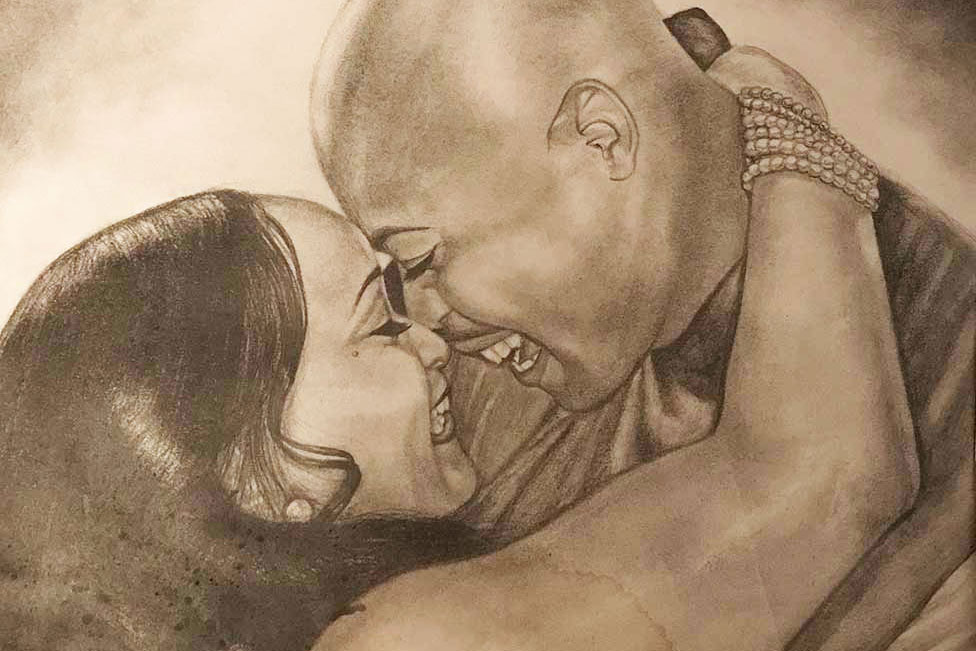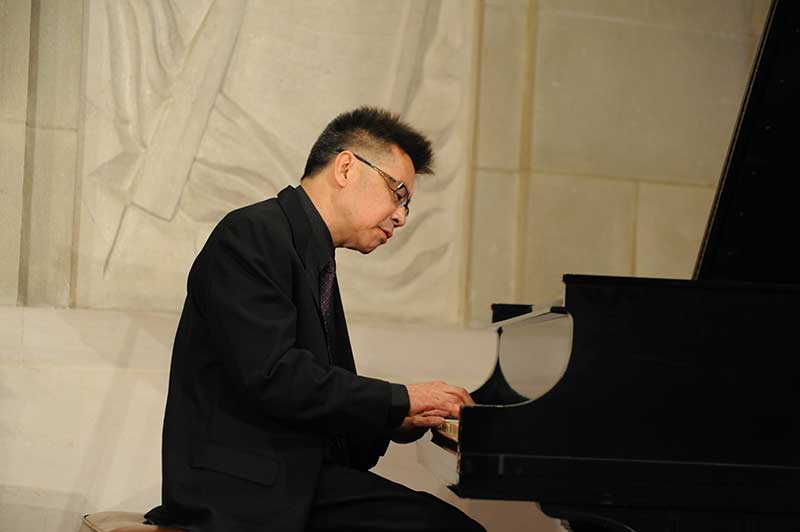Sat July 12th Open 11 AM–5 PM
Seeing the Essentials
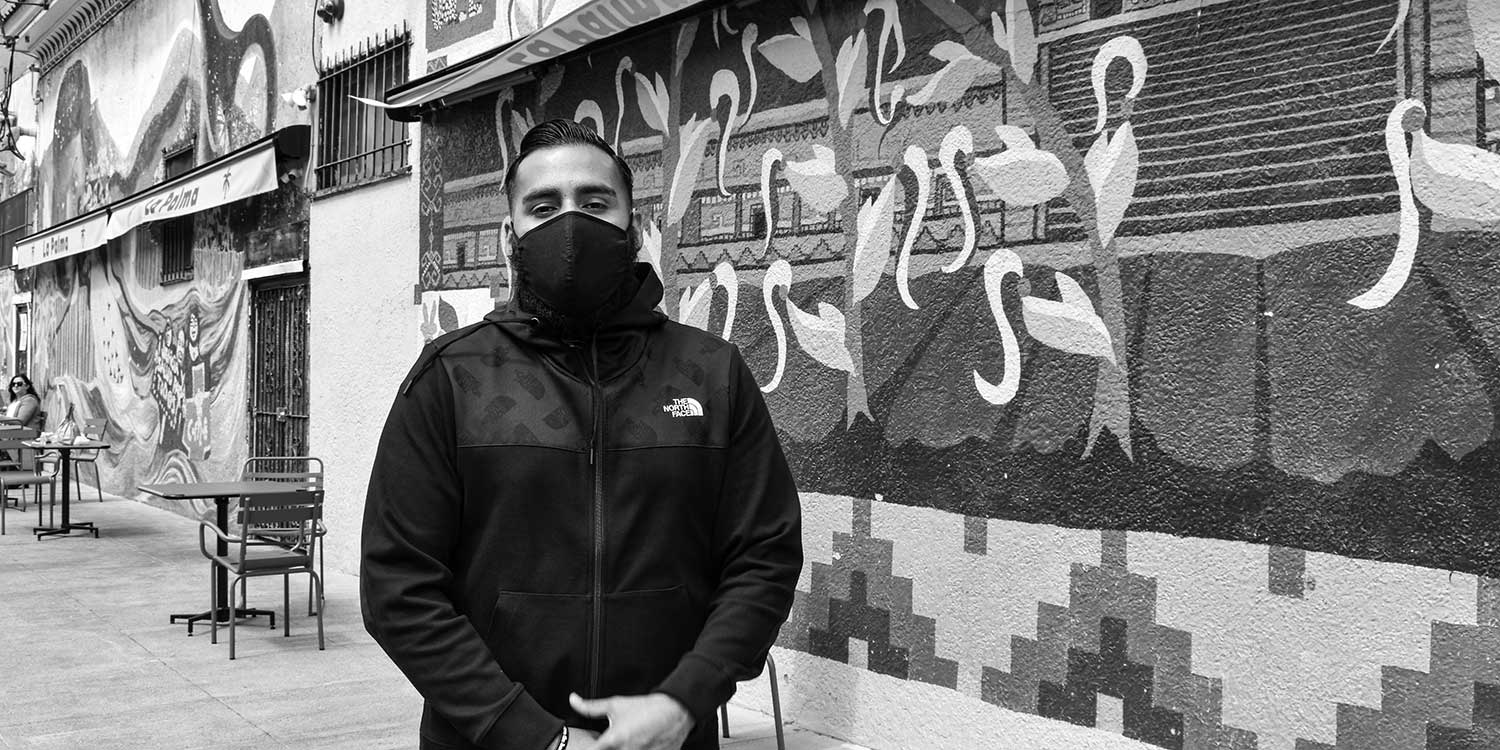
The 2019-2020 YBCA Public Participation Fellow cohort was originally gathered to collaborate and build on communities-based projects that demonstrated the mobilizing of public participation. However, as the Fellows worked on bringing their work to fruition, the world was hit with COVID-19. The cohort were then challenged to grapple with the question: what is public participation now?
Cheyenne Concepcion (b. 1991, Los Angeles) is a multi-disciplinary artist and designer based in San Francisco. Her art practice is usually research oriented and investigates the politics of space through installation, speculation, cartography and collecting. As a 2019-2020 YBCA Fellow, she developed The Essentials, a photo essay documenting essential workers in the Mission District of San Francisco.
Concepcion sat down with YBCA Curatorial Project Manager Fiona Ball on June 30, 2020 to discuss how her fellowship project pivoted in response to the COVID-19 pandemic, the importance of exploring concepts of place, and seeing essential workers as our modern day superheroes.
Fiona Ball: Thanks for taking the time to chat with me, Cheyenne. Tell us a bit about yourself and your practice.
Cheyenne Concepcion: I am a designer and an artist. I’m a designer first and found my way into art in grad school and I get so much fulfillment through my art practice. By day, I work at an architecture firm called Spiegel Aihara Workshop. My art practice is more of my voice though, so it tends to be political but equally interested in space and urbanism, having that architectural interest. A lot of my work explores the politics of space, and that is really broad, but much of it is inspired by where I grew up, in San Diego and Los Angeles, and having immigrant parents. My work draws on my interest in urbanism, public space and the socio-cultural aspects that ultimately define our built environment.
I think that’s what brought me into the YBCA fellowship before COVID. My work was originally a project called The Borderlands Archive where I collect objects, research, photos, mappings of things that have crossed the border or trace cross-border connections. That was my original YBCA project. And then we pivoted. I do work about urban environments and their sociopolitical aspects and have gone about it in different ways. But what I started with was more of an archive project where I’m the archivist and researcher, and the project is presented as an alternative institution that asks others to join in to create new narratives about “the Borderlands.”
FB: Which we were originally hoping to present at YBCA, and then the pandemic began. So what originally drew you to becoming a YBCA Fellow? How did you hear about the program? What encouraged you to apply?
CC: I think I knew someone who did it in the past. She was a Berkeley grad, and that’s where I went to school. But that was a couple of years ago and I didn’t really give it any thought. And then I was looking for a home for my archive project and the brief for the open call for fellows was really in line with that project. I felt I had a good chance because it was in line with central themes of the call like identity, race, people’s sense of belonging to place. Sometimes our sense of belonging doesn’t match our citizenship, I have experienced this firsthand. There were a lot of common thematic undertones, which I felt was a great fit.
But of course I knew YBCA prior, colleagues and friends of mine were in the Bay Area Now exhibition, so I got on your mailing list I think where I learned about the fellowship. It seemed like a good fit for my project, and I really wanted to work with YBCA at some point, just because of your mission. It’s a lot different than other museums in San Francisco.
FB: Thank you. So this year’s fellowship theme was originally around mobilizing and uplifting communities. So how did you see both your original project and your current project as connecting to that theme?
CC: My original project is almost exactly that theme, because I created this cheeky alternative organization. Often these stories don’t get told by major institutions and it’s a community-generated collective archive with maps, collected objects and research that draw on themes of identity and race.
But in this new project, the project I pivoted to, it was hard for a lot of us fellows because our projects had to do with space and you can’t be in space anymore, and it had to do with people, but you can’t really be around people anymore either. Other fellows in the cohort are teachers and they couldn’t be with their students. And so a lot of us, when we first had to pivot, were pretty confused and went through a process with Anna Lisa [Escobedo, YBCA Engagement Project Manager] to try to understand what even public participation is during COVID when you can’t have proximity to other human beings.
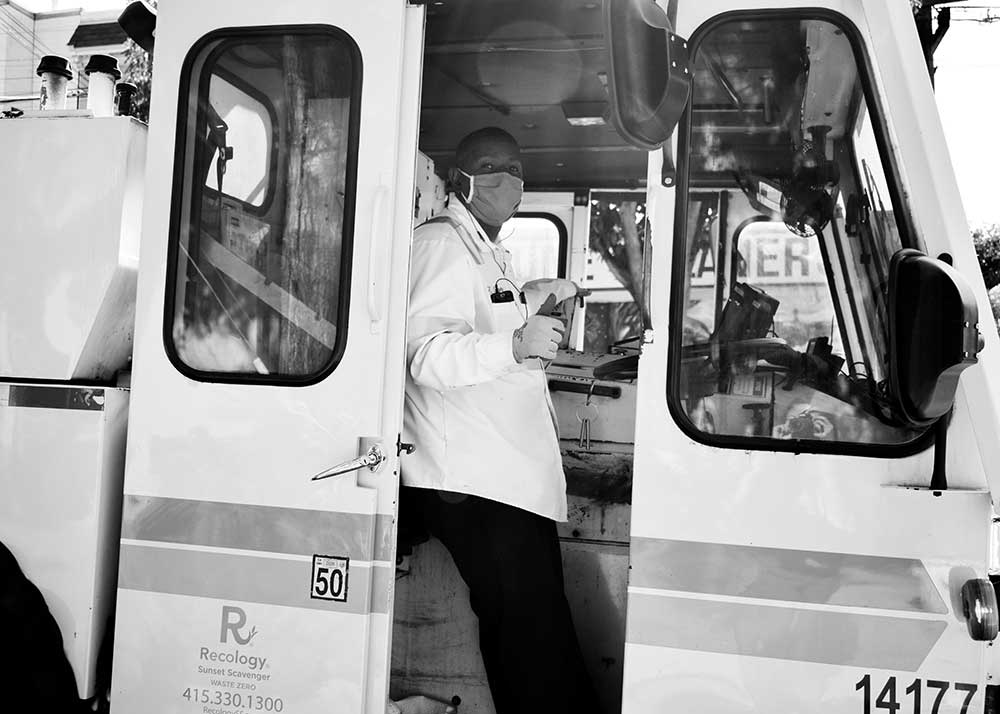
I don’t know if my project exactly is the answer to public participation, but I do think that it uplifts and highlights voices of people who don’t have a voice typically. I focused on taking portraits of essential workers. Something I experienced with my family and friends, is that essential worker commonly means healthcare worker, a doctor or a nurse. But it’s actually so much more broad than that. And those people who aren’t recognized, like the janitors, the food service workers, and the farmworkers are unrecognized. I was super interested in taking portraits of those workers. I have portraits of nurses because they are a huge part of it, but I wanted to highlight the workers and people that are laboring behind the scenes that aren’t getting appreciated on the same level.
FB: When I think about the term, essential, I think of almost the bare necessities, the bare bones. And then what your project really does is it actually reveals the layers of people and how we don’t want to essentialize this idea of the essentials. It’s actually like an entire network of support that keeps us going and keeps our society moving. How did you arrive at this series of photo essays? What was your thought process to get there?
CC: We were having conversations together, the YBCA Engagement team and myself, and we were talking in the very beginning, mid-March or late March, about pivoting this project. And I really didn’t know what I was going to do, but I was fascinated by essential workers because they were the only ones that could go outside. I think I was inspired by the fact that everyone at seven o’clock was banging pans outside and going crazy to thank the healthcare workers, which I think is great. I don’t want to take any shine away from healthcare workers, but something in all of my work is that I try to see undertones. I’m super interested in race and what place means.
There was also a lot of talk about the Mission where I live, and the potential impact of COVID-19 on marginalized communities. People were predicting that food workers and low wage workers and minorities were going to be the most affected. It was almost a documentarian project, in real time, showing what is happening here in the Mission.
The new theme for the YBCA fellows became “creating in COVID”. I just literally took the parameters of being able to create in COVID, I took my quarantine walks and my camera and just moved forward. In this pandemic, you can’t really touch anyone, you can’t touch anything at all really, and my other project collects things and is about public participation…so what could I do? I could stand six feet away from someone and take a photo. It was a literal translation of what I could do with space during this time. It was a really quick and fast reaction to the world we live in now.
FB: And how did you approach these essential workers who you ended up documenting considering that everyone was so high on alert and probably didn’t want strangers coming even six feet of them?
CC: I got a lot of nos, probably more nos than yeses. A lot of people weren’t comfortable with it and I don’t know if it’s just the six feet thing, maybe it could have been other things. I would take photos during my walk around the neighborhood. I ended up taking a lot of photos of the businesses near me, the places that I ate at and shopped at. They know who I am and I could just be like, “I’m going to buy this. How are you? How are your kids? Oh and, can I take a photo of you too?” So it was a little bit of that, a little bit of convenience too. Though, I was cognizant of the different jobs these essential workers we’re doing. I made sure to ask a man collecting garbage, or delivering food, or selling goods on the sidewalk, this project was not only about race but about labor too.
FB: Then did you have conversations with the people you were documenting or was it a quick shoot and go? What was the format?
CC: I had conversations with a couple people, but other times I didn’t, for example I took a photo of a guy working at Recology because he was literally taking the trash out in front of my house. And then I ran after his garbage truck and he was still in it, driving and I was like, “Stop!” I wasn’t able to talk to everybody, but I did have patience. If I didn’t know them, folks were definitely uneasy. Asking me, “Where is this photo going?”
Someone asked me, “You’re not an internet troll, right?” I got a lot of that. Then some people were like, “Give me your number? And text me whenever this goes live.” Some people wouldn’t trust me initially and I’d have to talk them through it. When we would have conversations, it was mostly about how they felt about the pandemic. I was really interested in what their employers were doing for them. I was curious both about the essential worker and the essential businesses. It turns out, essential workers are often left unprotected and underpaid, working at a time of such high risk. This risk is so important. Sometimes they were the owner of their business, but a lot of the people that I talked to I asked, “Do you even feel safe coming to work every day?” Almost 90% said no.
They would say, “I don’t want to be here. But I have to go to work.” And that’s a choice low wage workers, often minorities, have to make. It’s a matter of survival.
FB: I think this is actually really important to put out into the world. I keep hearing the term toxic optimism in my head when I hear people say things like, “We love our essential workers, they’re amazing, they’re heroes,” which is totally true, but let’s also not put them in a position where we think that they’re fine with the situation they’re in. They’re doing it for survival because they have to, but they’re also putting so much at risk and are aware of that exploitation.
CC: And a lot of it IS survival. It’s survival mode for a lot of these people and a lot of essential workers, at least the people I’ve talked to, are getting a portion of what they used to get paid because the business they work for is struggling hardcore. So it’s complicated. The benefit to the risk of going to work is so off, but really it’s like they have nothing else. Again, this risk to reward for essential workers is so off-putting and something I believe should be addressed by our government.
FB: And if you don’t trust that the governmental social support will really catch you, you feel you have no choice. So what do you hope to convey through this photo essay? How are you hoping people will receive it?
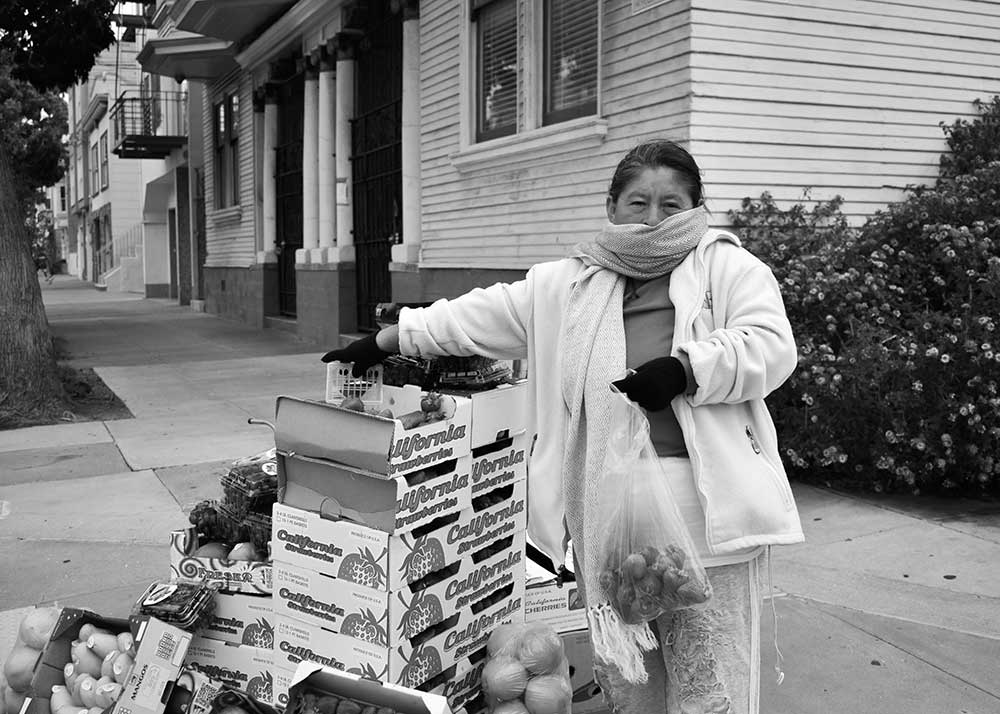
CC: I tried to be really subtle with this photo essay. I wanted it to come off positive from the jump so that people are open to receiving it, then I wanted to layer in the intricacies, the details of the environment in the photos, the beautiful brown-skinned bodies behind the masks. And I think that what I tested, worked, I tried it with my family [laughs], since I feel my projects are usually critical of some American ideal. I feel that’s a real undertone in my work. And I didn’t say anything about race upfront. I didn’t say anything about the labor. I didn’t say anything about inequity at all. I just was like, “I’m honoring essential workers.” My Aunt was like, “I love this project and I get it.” I feel people get it because it’s a little bit more palatable, but I hope that when people look at the photos, they see that I really tried to capture not only their faces, but their environments.
And then everyone in the photos is masked. I love the masks in the photos because it ties into the idea of a superhero, but it is also a little piece of armor. Everyone was hiding behind it in a way. But I also want people to see that the fact that it’s non-white people that are getting used, and they’re the ones on the front lines, as they say, and underpaid and underrepresented.
And so I’m disguising it as a real positive, these are our heroes, but then I hope they see in the photos what the real message is without me having to define it clearly. If you tell people how to experience something, then you’ve already done all the work for them. I hope that people notice what I was trying to convey and notice the kind of person that is at risk. And that there’s a real big difference between essential and unprotected and essential and forgotten.
FB: I think that really works in the way that you give each image a very limited caption. Immediately, when I was looking on your website, I was like, “Oh, where’s the statement from this individual? Or where’s the description?” I was looking for some didactic to explain more about this person, but instead you give us almost what we would get if we just saw that person on the street, barely anything more. And it really forces you to focus on the image and think about the individual and provide some space for reflection rather than just reading a paragraph and then moving onto the next one.
You speak about the fact that you are trying to do this in a little more of an ambiguous way without telling the viewer what exactly they should be feeling, and I think that works in the way that you almost, similarly to the mask, hide some of the information from your viewer.
I want to go back to your note about superheroes. You talk about how you almost see The Essentials as a Justice League. Can you talk a little bit more about that idea?
CC: There was a lot of talk, about the “war with the invisible enemy.” The way the media and politicians discussed preparing for COVID, it felt like we were almost getting ready for war. And our essential workers were the soldiers, our best soldiers, an elite group called “The Essentials.” This led to thinking about superheroes, like the Justice League is such an epic name. “The Essentials” also has that tone. I wanted to then twist those words to highlight the dichotomy between who these people are (often low wage service workers of color) and what this inflated name is. I think that also highlights the inflatedness of the word “essential” and creating a Justice League out of this project and highlights the inequities in my opinion.
If COVID never happened, we wouldn’t think of restaurant workers and farm workers as superheroes. But flipping it and spotlighting this group of minority, low wage workers, often working in harsh conditions, gives us all an opportunity to view them as superheroes, and they deserve it.
I didn’t draw anything or put capes on anybody, it’s strictly words and getting people to see it in that light. I don’t want people to stop celebrating them, but I also want people to recognize that they are heroes and deserve hazard pay, paid time off, etc. And a lot of these workers, they don’t have even time off and they work seven days a week. And we’re finding out that most of the people who are getting exposed to COVID are essential workers. And so no one has done anything about it yet. And, it’s time to do something concrete to protect our heroes, cheering in celebration isn’t enough.
FB: Why do you decide to focus specifically on your own neighborhood? Was it because of the restrictions of the pandemic? Was it to document one specific geographic area? Explain a little bit about that.
CC: Well, my work is often site-specific. I really get interested in place, and yes, there is the fact that I’m not going anywhere right now, but also the fact that the Mission has been proportionally more affected as a neighborhood than any other in San Francisco. We’re finding that 50% of people with COVID in San Francisco are Latinx and live in the Mission. Half of the people that have COVID are here, and so I find that with photography and portraiture, there is value in going to the epicenter of the issue. Luckily it’s not as bad as other cities, but this is the epicenter of our city.
There’s a lot of things about the Mission that contribute to that. It’s the way people live with other families, multiple families in one household and working class. I grew up in a home very similar. I lived with my aunt’s family and my uncle’s family and my own, we were poor, so I see how the virus travels so fast. In the Mission there are a lot of people renting, there are a lot of service workers too, I maybe should specify that because it’s mostly in the Mission. I didn’t really go to the fancier parts, I stuck around my house. I live in the 24th Street Corridor and it was where everything was going down and I wanted to talk about it. It’s not an in-depth study, so I don’t want to make claims that aren’t mine to make. I didn’t do in-depth interviews or anything, I sparked conversations, but this is the epicenter of COVID in the Mission. And it has, I feel, a huge part to do with working conditions of Mission District dwellers. I wanted to capture the humanity behind the COVID data getting thrown at us daily.
FB: I really hope that it builds empathy. I keep seeing these images of people eating at restaurants and going to stores without masks on and I think about how there is no care for the workers around them. You are highlighting those workers with this series. Thank you Cheyenne for sharing more about your work and The Essentials.
CC: Thank you.

